How Many Species of Rhinoceros Are There?

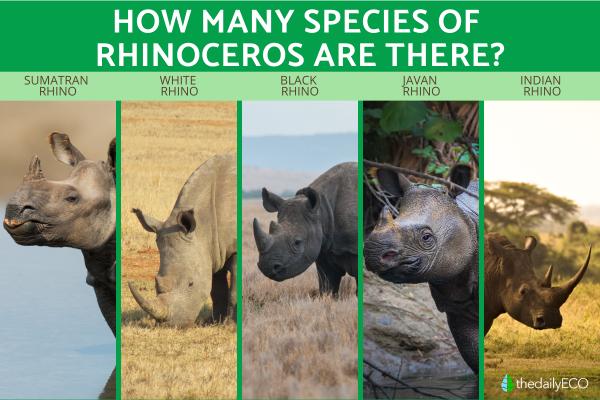
Rhinos are, without a doubt, one of the most impressive creatures on our planet. These prehistoric-looking beasts seem to have stepped right out of another era. Though once widespread across Africa and Asia, today just five rhino species hang on in the wild. Each species has evolved unique adaptations to its environment. Some are browsers, some are grazers. Some prefer dense forests, while others roam open grasslands.
In the following article by thedailyECO, we will look at each of the five rhinoceros species, highlighting their main characteristics and the key differences that set them apart.
How are rhinos classified?
Rhinoceroses belong to an ancient lineage of mammals that once roamed across much of the planet. Within the scientific hierarchy, these creatures are classified as:
- Kingdom: Animalia
- Phylum: Chordata
- Class: Mammalia
- Order: Perissodactyla
- Family: Rhinocerotidae
This taxonomic family is divided geographically between two continents, with different rhinoceros species evolving in isolation from each other.
- Africa (two species): the white rhinoceros and the black rhinoceros, both with two horns.
- Asia (three species): the Indian rhinoceros, the Javan rhinoceros, and the Sumatran rhinoceros.
These five rhinoceros species represent the last survivors of a once-diverse family. Interestingly, despite their names, both African species are actually grayish in color.
The Asian rhinoceros species typically have more pronounced skin folds and, except for the Sumatran rhino, just one horn.
The following sections explore each species in detail, highlighting their distinctive characteristics, behaviors, habitats, and conservation challenges.
Sumatran rhinoceros (Dicerorhinus sumatrensis)
Anyone lucky enough to spot a Sumatran rhino in the wild would notice right away that it doesn't look quite like the rhinos commonly seen in zoos or nature documentaries. As the smallest and most ancient-looking of all rhino species, the Sumatran rhino had a reddish-brown, shaggy coat that gives it an almost prehistoric appearance. These living fossils, which are the most primitive of all living rhinoceroses, are the closest modern relatives to the extinct woolly rhinoceros that roamed Europe and Asia during the Ice Age.
The Sumatran rhino (Dicerorhinus sumatrensis) navigates dense mountain and lowland rainforests with agility. Standing just 4-5 feet tall at the shoulder and weighing approximately 1,500-2,000 pounds, it is about half the weight of its African cousins.
They have two horns that are smaller than those of African rhinos and heavily folded skin that often appears muddy from their frequent wallowing in forest pools and mudholes. Their prehensile upper lip works like a finger to grab leaves and twigs, while their complex sense of smell compensates for relatively poor eyesight.
Unlike other rhino species that prefer open grasslands or woodland edges, Sumatran rhinos are forest dwellers. They create tunnel-like paths through thick vegetation and possess an incredible ability to climb steep, slippery slopes that would challenge many smaller animals. Perhaps most surprising is their swimming ability, they don't hesitate to cross rivers and can even rest underwater with just their nostrils above the surface.
Their vocalizations include an unusual whale-like song used for communication, which makes them the most vocal of all rhino species. Highly solitary, adults come together only to mate, with females giving birth to a single calf only once every 4-5 years after a 15-month pregnancy.
Scientists recognize three subspecies, though one might already be extinct:
- Western Sumatran rhino (D. s. sumatrensis)
- Bornean or Eastern rhino (D. s. harrissoni)
- Northern rhino (D. s. lasiotis) – probably extinct
Their situation could hardly be more precarious. Fewer than 80 Sumatran rhinos survive today, scattered across fragmented rainforest patches. These animals face a perfect storm of threats: rampant poaching for their horns, devastating habitat loss from logging and palm oil plantations, and now a reproductive crisis where scattered individuals can't find each other to breed.
Without dramatic conservation intervention including captive breeding programs and intensive protection of remaining habitat, these living relics from the Miocene epoch may vanish within a generation.
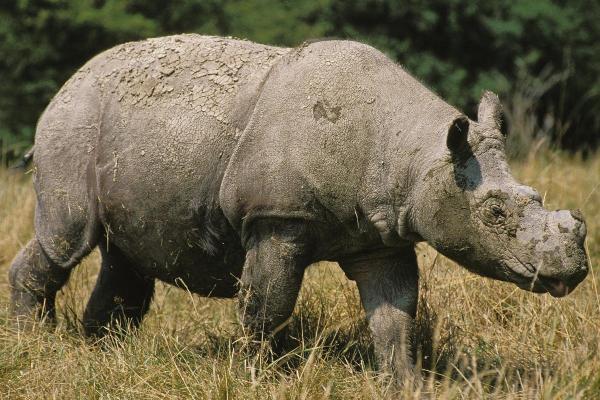
White rhinoceros (Ceratotherium simum)
White rhinos aren't white at all. Instead, they're gray, just like other rhinos. The name likely comes from a misunderstanding of the Dutch word "wijd", which means "wide," referring to their lips.
The white rhino is the second-largest land mammal after elephants. They measure 11-15 feet long, stand 5-6 feet at the shoulder, and males weigh over 3 tons. Their most noticeable feature, however, is their wide, square upper lip, which helps them graze on grass. Unlike rhinos that eat leaves, white rhinos crop grass close to the ground like lawn mowers. As a result, their head shape, with a hump on the neck and a low-hanging posture when walking, makes them easy to identify.
These grass-eaters live in open savannas with short to medium grasses. Unlike their Asian cousins, they prefer areas with good visibility, such as grasslands, open woodlands, and scrublands across southern and eastern Africa. Throughout the seasons, they move based on grass quality. Because they need shade and must drink every 2-4 days, they're always near water sources.
White rhinos exist as two subspecies with drastically different stories:
- Southern white rhino: considered a conservation success, rebounding from fewer than 50 animals in the early 1900s to about 17,000-20,000 today.
- Northern white rhino: nearly extinct, with just two females left at Ol Pejeta Conservancy in Kenya. The last male, Sudan, died in 2018.
Compared to other rhinos, white rhinos are more social, forming small groups called "crashes," while males patrol territories of 1-3 square miles. Importantly, they create dung middens (toilet areas) that serve as communication points. Since their skin gets sunburned easily, they wallow in mud for protection. Despite their bulk, white rhinos can run at 30 mph when threatened, which is faster than most humans.
Although conservation efforts have helped southern white rhinos recover, they still face significant threats. Poachers continue to hunt them for their horns, which are sold for traditional medicine and status symbols despite having no special properties. Additionally, climate change with increasing droughts threatens their grassland habitats.
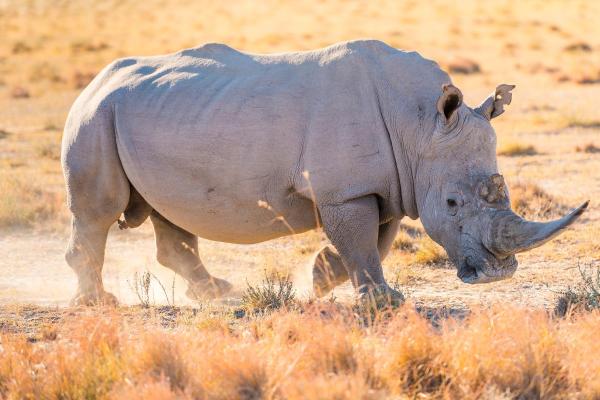
Black rhinoceros (Diceros bicornis)
Black rhinos aren't black either. Like white rhinos, they're simply gray. The key difference, however, is their hooked upper lip, which evolved for browsing on leaves and branches rather than grazing on grass.
The black rhino (Diceros bicornis) is more compact than the white rhino. They stand around 5 feet tall and weigh about a ton. Their most distinctive feature is their prehensile upper lip that curves and points like a finger, allowing them to grab leaves from thorny trees and other plants. Furthermore, they hold their heads higher than white rhinos, making them easy to tell apart even from a distance.
In contrast to white rhinos that prefer open plains, black rhinos live in varied habitats with plenty of woody plants. They can be found across eastern and Southern Africa in environments ranging from semi-desert scrublands to forests.
As browsers, they select specific plants and parts of plants rather than consuming vegetation indiscriminately. Their diet varies seasonally and regionally, adapting to what's available. Additionally, their hooked lip is capable of selecting individual leaves or stripping bark from branches.
Black rhinos exist as four subspecies:
- South-central black rhino (D. b. minor): is the most numerous today, found in South Africa, Zimbabwe, and southern Tanzania.
- Eastern black rhino (D. b. michaeli): its population is stable in protected areas in Kenya and Tanzania.
- Southwestern black rhino (D. b. bicornis): its population is recovering in Namibia and South Africa.
- Western black rhino (D. b. longipes): declared extinct in 2011 after extensive searches found no surviving individuals.
Black rhinos are known for their bad temper. They charge more often than white rhinos and may target vehicles, trees, or boulders when startled. This behavior likely developed as a defense in bushy habitats where visibility is poor. To compensate for poor eyesight, they have excellent hearing and smell. Additionally, they create mental maps of their territories, including every water hole, salt lick, and food source, following the same paths for years.
In the 1960s, their population stood at around 70,000 individuals across Africa. However, a devastating wave of poaching driven by demand for rhino horn reduced their numbers by 98%, leaving just 2,500 animals by the early 1990s. Since then, intensive conservation efforts including armed protection, habitat preservation, and breeding programs have helped numbers increase to approximately 5,500 today. Nevertheless, they remain highly vulnerable to poaching and habitat loss.
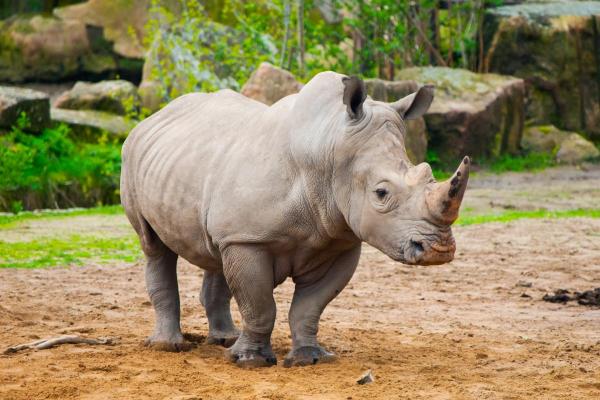
Javan rhinoceros (Rhinoceros sondaicus)
Javan rhinos are so rare that most rhino researchers have never seen one in person. As a result, they're known mostly from camera trap photos and are almost never observed directly in the wild.
The Javan rhinoceros (Rhinoceros sondaicus) is one of the most endangered large mammals on Earth. Once found throughout Southeast Asia, today only 74 animals survive in Ujung Kulon National Park on Java's western peninsula.
These medium-sized rhinos stand about 5 feet tall and weigh up to 5,000 pounds. Their appearance is characterized by several distinct features such as a single horn (females sometimes have none), thick skin folds that look like armor plating, and a pointed upper lip for grabbing vegetation.
Javan rhinos need specific habitat conditions to survive. First and foremost, they require dense, tropical lowland forests with plenty of water and understory plants. Additionally, they need mud wallows and fresh water, preferring areas with a mix of habitats including some open spaces for browsing.
Although difficult to study, researchers have learned about these elusive animals through cameras and DNA analysis. Their diet consists of hundreds of plant species. When available, they also eat fallen fruits. Interestingly, they're selective eaters, often traveling long distances to find preferred plants that might make up just a small portion of their diet.
Perhaps most remarkable is the Javan rhinos' incredible stealth. Despite their size, they move through dense forest almost silently. Over generations, they've maintained networks of paths through thick vegetation. With excellent hearing and smell, they easily avoid humans. While they generally live alone, their ranges often overlap, though individuals typically avoid direct contact.
Unfortunately, their situation is extremely precarious. Not only is their population tiny, but it's also concentrated in one location, making them vulnerable to disease, tsunamis, and volcanic eruptions. Although conservation plans include establishing a second population elsewhere, progress has been slow. Furthermore, females give birth only every 4-5 years, making population growth very slow.
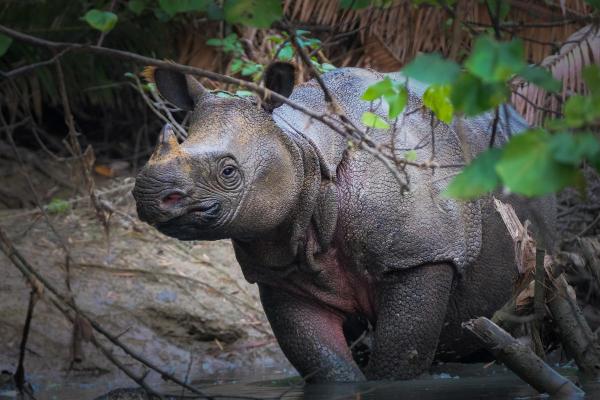
Indian rhinoceros (Rhinoceros unicornis)
The Indian rhino looks like something from a medieval battle. Its thick skin folds and single horn make it the most recognizable of all rhino species and, fortunately, a conservation success story.
The Indian rhino, also known as the greater one-horned rhinoceros (Rhinoceros unicornis), has a unique profile. It had deep skin folds that create segments around the shoulders, neck and rump, resembling armor plating. In addition, the skin has bumps or "rivets" across the shoulders and upper legs.
A single horn sits on the snout, usually 8-24 inches long. These rhinos stand nearly 6 feet tall and weigh 4,000-6,000 pounds, with large males exceeding 7,000 pounds. As a result, they're the second-largest rhino species after the white rhino and the largest Asian rhino.
Water fundamentally shapes their lifestyle. For instance, they typically live along major rivers like the Brahmaputra. Their daily routine alternates between feeding in grasslands and returning to water to cool off. During monsoon floods, they move to higher ground but stay near water. Unfortunately, this dependence on wetlands has made them vulnerable as humans drain these areas for farming.
Although they primarily eat grass, Indian rhinos have a varied diet. They also consume aquatic plants, fruits, crops, and tree branches when other food is scarce. Using their keen sense of smell, they can find plants underwater and will submerge their heads to reach them.
They communicate through various sounds such as honks, snorts, roars, squeaks and a "chuffing" sound during mating. Males establish territories using urine, dung piles and horn scraping. Generally solitary creatures, only mothers and calves form lasting groups.
The Indian rhino demonstrates conservation success. After being hunted to fewer than 100 animals by 1908, protection efforts in Nepal and India have helped numbers grow to over 3,700 today. Notable achievements include Nepal's Chitwan National Park and India's Kaziranga National Park, where anti-poaching efforts and habitat protection have been effective.

If you want to read similar articles to How Many Species of Rhinoceros Are There?, we recommend you visit our Wild animals category.
- Save the Rhino. Available at: https://www.savetherhino.org/rhino-info/rhino-species/
- IUCN Red List. Available at: https://www.iucnredlist.org/
- Rhinocerospedia. Available at: https://www.rinocerontepedia.com/










